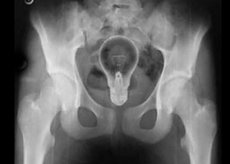Foreign bodies of the rectum
Last reviewed: 23.04.2024

All iLive content is medically reviewed or fact checked to ensure as much factual accuracy as possible.
We have strict sourcing guidelines and only link to reputable media sites, academic research institutions and, whenever possible, medically peer reviewed studies. Note that the numbers in parentheses ([1], [2], etc.) are clickable links to these studies.
If you feel that any of our content is inaccurate, out-of-date, or otherwise questionable, please select it and press Ctrl + Enter.

Gallstones, coprolits and swallowed foreign bodies (including toothpicks, chicken and fish bones) may linger in the anorectal zone.
Urinary stones, vaginal pessaries, surgical sponges or instruments can be found in the rectum. Foreign bodies of the rectum, sometimes unusual and / or associated with sexual games, can be injected into the rectum intentionally, but often become difficult to remove. Some foreign bodies penetrate the rectum wall, others migrate above the anal sphincter.
Symptoms of foreign bodies of the rectum
Sudden, painful pain during defecation should cause suspicion of penetration of a foreign body, usually located in the area of anorectal transition or above. Other manifestations depend on the size and shape of the foreign body, the duration of its presence in the rectum, the development of infection or perforation.
Diagnosis of foreign bodies of the rectum
Foreign bodies are usually located in the middle part of the rectum, in the area of the rectal bend anteriorly, which they can not overcome. They can be palpated in finger research. Examination of the abdominal cavity and radiography are necessary to exclude possible intra-abdominal perforation of the rectum.
Removal of foreign bodies of the rectum
If the foreign body can be palpated, local anesthesia is performed by subcutaneous and submucosal administration of a 0.5% solution of lidocaine or bupivacaine. The posterior passage is dilated with a rectal retractor, the foreign body is captured and removed. If a foreign body is not palpable, the patient must be hospitalized. Peristalsis usually moves the foreign body down to the middle of the rectum, which then allows the removal of the object. Removal of a foreign body of the rectum with the help of a sigmoidoscope or rectoscope is rarely successful, and sigmoidoscopy usually causes the foreign body to migrate proximally, delaying its extraction. Regional or general anesthesia, laparotomy with extrusion of a foreign body to the anus or a colotomy with removal of a foreign body are rarely used. After removal of the foreign body, it is necessary to perform sigmoidoscopy to avoid injury to the rectum or perforation. Removal of a foreign body of the rectum can be a high risk and should be performed by a surgeon or gastroenterologist with experience in removing foreign bodies.


 [
[